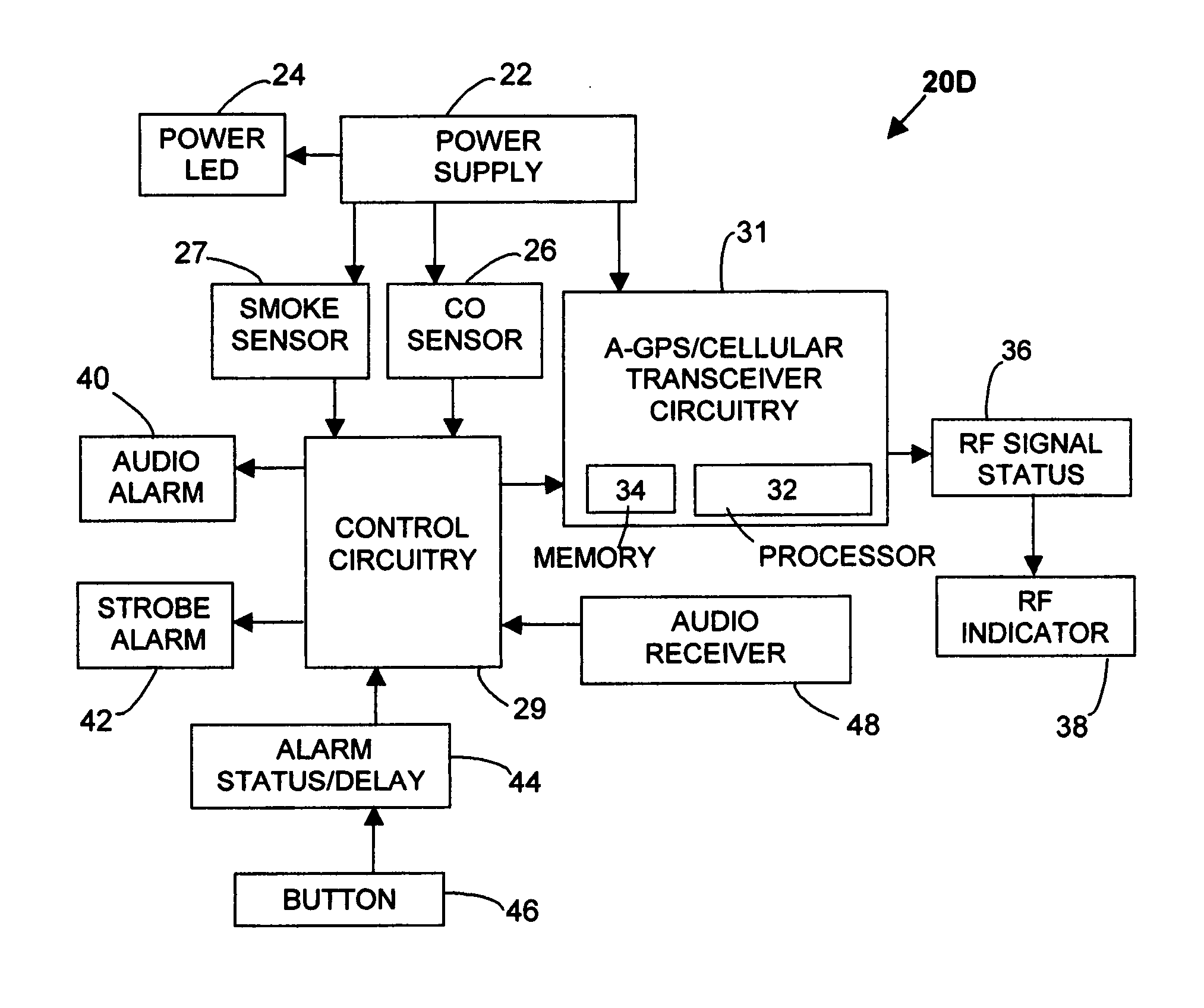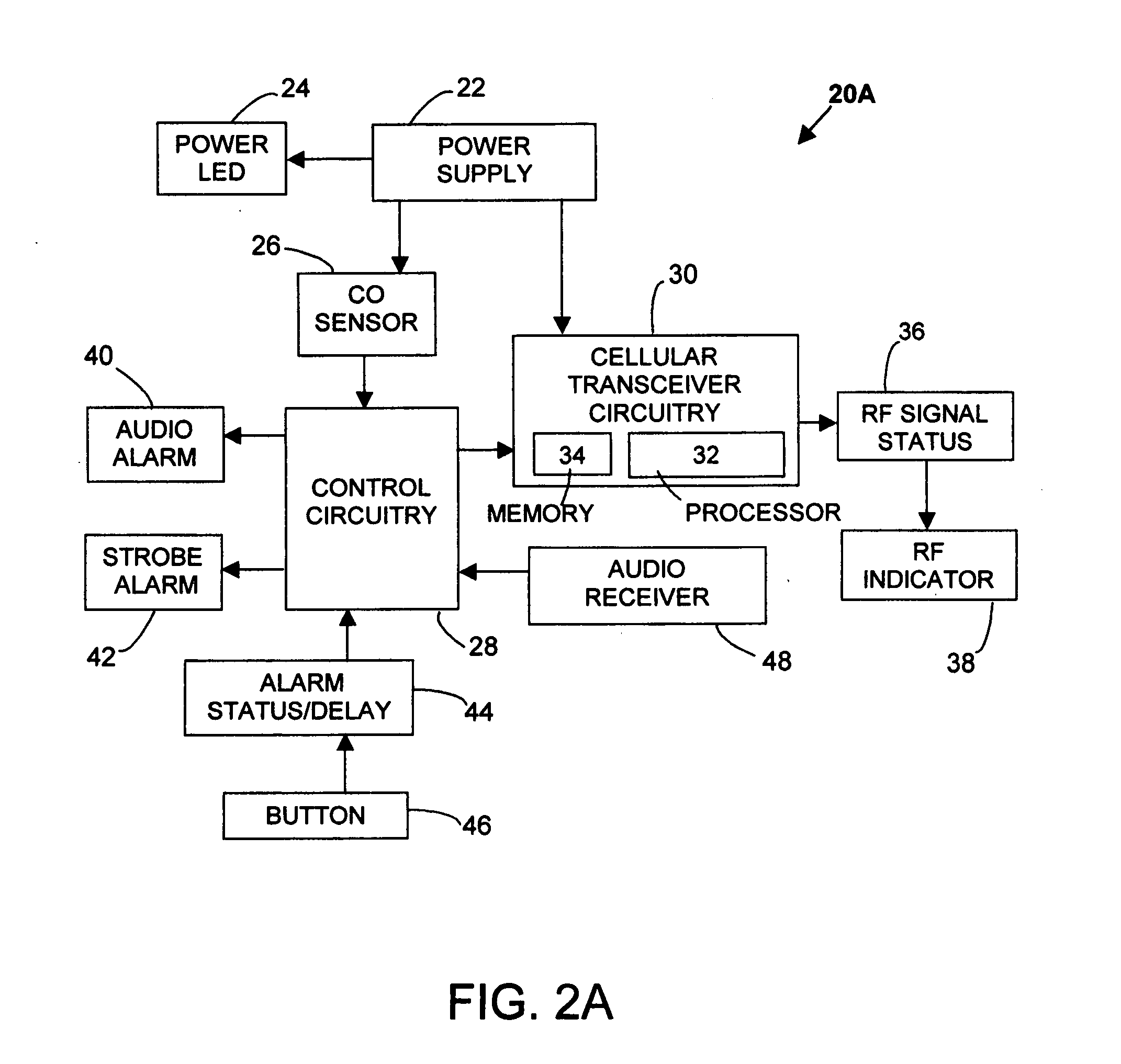Although
smoke and fire are often detectable by
sight and smell, carbon monoxide is known as the “silent killer,” due to its tasteless, odorless, colorless, and poisonous properties.
In addition, running automobiles, recreational vehicles, and other
combustion engines produce poisonous carbon monoxide.
Further, while fire is known mostly for generating smoke, it can also generate poisonous carbon monoxide.
However,
delay or failure of any one of the
key factors dramatically increases the dangers of carbon monoxide, smoke, and fire.
Furthermore, heavy sleeping, intoxicated, persons on medications, and high-risk (e.g., children, elderly, physically challenged, sensory-impaired) occupants may not hear or otherwise respond to the activated alarm sound before being overcome by carbon monoxide or smoke.
Even carbon monoxide alarms equipped with a visual alarm or strobe may not awaken this category of occupants due to the aforementioned and other design limitations.
Despite solving some of the problems of
single station carbon monoxide and smoke alarms, drawbacks exist with the above-mentioned interconnected alarms.
For example, although interconnected alarms may alert building occupants to carbon monoxide or fires in remote or unoccupied areas, if the building is unoccupied or vacant, the danger often goes undetected as the carbon monoxide level increases or a fire spreads to out of control.
First, such systems are cost prohibitive for carbon monoxide monitoring or
fire protection, due to the numerous components and sizable installation costs.
Because of these costs, non-homeowners or persons with low-income or marginal credit ratings may be unable to afford installation costs and monthly service fees.
Second, integrated security systems require skilled technicians to install, test, and maintain.
Furthermore, these systems often employ a separate landline or wireless auto-
dialer component, which requires the user to subscribe to separate landline or wireless telephone service, and utilize off-site commercial central
station monitoring facility, requiring additional monthly fees.
Still another
disadvantage is an off-site central
station monitoring facility must retransmit any alarm events to a 911 operator.
A further limitation of all of the above-mentioned carbon monoxide and smoke alarms, is that they are not specifically designed for installation in building structures undergoing construction, or an effective means for carbon monoxide or fire monitoring in vacant residences or commercial buildings.
In most residential and commercial buildings under construction, there is no means for carbon monoxide or fire monitoring, often no telephone service, and often no registered street address.
Because such buildings may be vacant during the off-
work hours, a build-up of dangerous levels of carbon monoxide or a fire may burn unnoticed before it rages out of control, causing danger to workers, fire damage to the said building, fire damage to adjacent properties, and increased danger to
emergency response personnel.
Although security systems that include carbon monoxide and
smoke detectors have the ability to automatically summon assistance through a intermediate commercial central
station monitoring facility, a key drawback of such systems and existing single and multiple station carbon monoxide and smoke alarms is their lack of effective means for automatic and direct notification to a 911 operator, often referred to as a 911 public safety answering point, of the specific nature and location of the carbon monoxide or fire emergency.
But oftentimes these telephones are located inside the dangerous area that the occupant is attempting to evacuate.
The main drawback is that an occupant who is attempting to use a telephone is often in a heightened state of
anxiety, confused, or injured, so spending time locating a telephone, dialing 911, waiting for a call connection, and verbally articulating the nature of the emergency and other detailed information to a 911 dispatcher can increase the chances of injury and waste critical evacuation and
response time.
Moreover, the previously mentioned intoxicated or high-risk occupants may be substantially limited in their ability to quickly locate a telephone and effectively communicate with a 911 dispatcher during a life threatening carbon monoxide or fire emergency.
However, with a growing number of households canceling their landline telephone service and going cellular-only, landline enhanced 911 service becomes unavailable to those households.
Although mobile cellular telephones are an important tool for general safety and emergency reporting, they still require a human user to operate, and are not specially designed for carbon monoxide or
fire safety.
Another issue is that in order to utilize a
cellular telephone to call 911 or use wireless enhanced 911 emergency location services, a user is often required to purchase or acquire a mobile
cellular telephone, and enter into a subscriber contract with a wireless carrier, which requires an activation fee and monthly service fees.
However, persons with low-income or with marginal credit ratings may be unable to afford a cellular subscriber contract.
However, these cellular telephones are not specialized for automatic notification to 911 operators in carbon monoxide or fire emergencies.
As described above, presently available conventional carbon monoxide and combination carbon monoxide / smoke alarms are primarily used for alerting building occupants with an audible or visual alarm, and presently available integrated security systems require an intermediate central station monitoring facility, but provide neither a means for automatic and direct contact to a 911 dispatch operator (i.e, a 911 public safety answering point), nor a means for automatic wireless enhanced 911
location determination.
 Login to View More
Login to View More  Login to View More
Login to View More 


